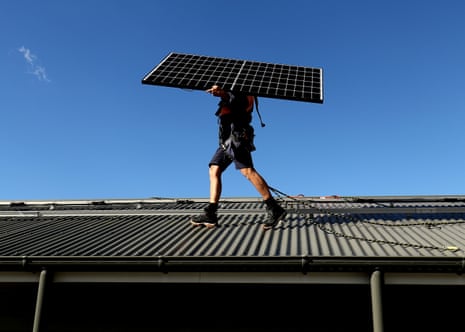Households are on track to add three gigawatts of rooftop solar capacity to the electricity grid this year but investment in large-scale wind and solar remains all but stalled, according to the Clean Energy Regulator.
The regulator said 1.4GW of capacity, from almost 160,000 rooftop systems, was added to the grid in the first half of 2023, which chief executive and chair David Parker said showed consumers were looking to save money on their energy usage while reducing their carbon footprint.
“Australia has among the best solar resources in the world and households and businesses continue to install rooftop solar at world leading rates,” he said.
Three gigawatts would bring the amount of rooftop solar capacity added to the grid close to the 2021 record of 3.2GW.
According to the regulator’s quarterly report, the increased capacity saw the share of renewable electricity rise to more than 36% of demand in the national electricity market. It is expected that will grow to 40% by December.
But the picture is different for large-scale renewable projects. The regulator has downgraded its expectations amid rising costs for components, engineering and construction.
In contrast to the uplift in small-scale renewables, Parker said it was a quiet first half of the year for new large-scale renewable energy investment commitments.
“We’ve downgraded our expectations and now expect 2023 investment may not reach three gigawatts,” Parker said.
It follows warnings from experts that the sector is not moving at a fast enough pace to meet an 82% renewable energy target by 2030.
The Australian Energy Market Operator warned in June that the country’s transition away from fossil fuels was moving too slowly with not enough investment in wind and solar farms.
The regulator said finding ways to streamline grid connection and fast-track new transmission would be critical.
after newsletter promotion
Tristan Edis, the director of analysis and advisory at Green Energy Markets, said the outlook was challenging.
“Getting to 82% will clearly require a lot more work from this federal government than lending some money for transmission lines and a few token community batteries and solar gardens,” he said.
In its most recent quarterly report, the Clean Energy Council said solar and windfarm developers were facing a “raft of barriers” in Australia despite strong political support.
The council said the first half of 2023 produced the slowest pace of final investment approvals in its six years of data tracking.
